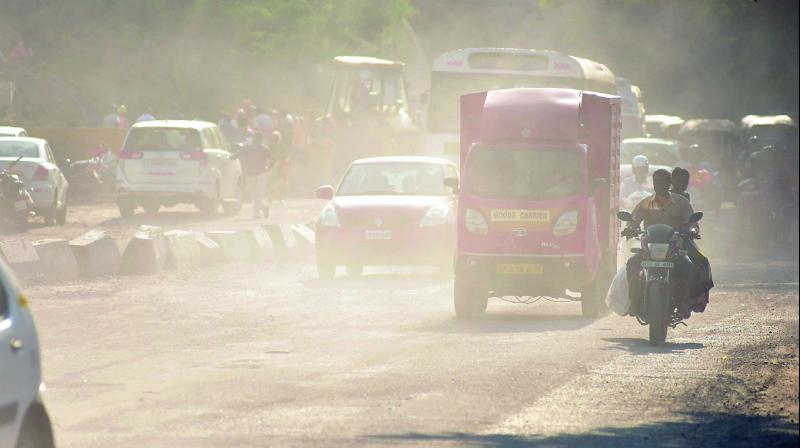Dust on roads from Hyderabad Metro Rail work makes breathing difficult

Hyderabad: Air pollution levels in the city have become a cause for worry because this is one of the major parameters in the Centre’s Swachh survey of India. The city records above permissible limits in respirable suspended particulate matter (RSPM) due to dust from under-repair roads and carbon monoxide pollution caused by vehicular exhaust.
Of the five parameters on which air pollution is judged, Hyderabad does poorly in two while rating as average on the others. In the 2015 Swachh survey, Hyderabad stood at the 19th position.
“The other parameters include sulphur dioxide and nitrous oxide (gases emanating from industrial sector). On this front, the city is in the safe zone as the two gases are within standard levels. The major concern is RSPM which is the result of the dust from roads that enters the bloodstream and causes various lung-related diseases and eye problems,” said environmentalist W.B. Prasanna Kumar,
The second issue of major concern is the carbon monoxide from vehicular emissions and from burning of leaf litter. “There is no separate disposal system for leaf litter. The waste, when burnt, releases carbon monoxide. RSPM and carbon monoxide are above the standard limits which is a matter of concern for us,” Mr Prasanna Kumar said.
The fact that Hyderabad fares badly with RSPM also indicates that the city does not have sufficient tree cover, he said. “The width of roads has been increased which is good but there is no planning for urban biodiversity. Trees act like a sink to absorb RSPM and carbon dioxide, reducing the particulate matter. The government’s Haritha Haram programme will help in the future if it is sustained. We need more tree cover in core areas.”
GHMC's Urban Biodiversity wing is looking to create plantations on spaces like government buildings, parking spaces and medians.
"Metro Rail will reduce vehicle pollution, and RSPM pollution will reduce when all roads are repaired.
Also, GHMC is creating more parking spaces and is looking at plantation at these sites. Various strategies are being worked out," said GHMC commissioner Dr B. Janardhan Reddy.
The parameters also include measuring of ozone and benzene (the organic chemical compound that gives petrol its smell) in which the city is in the safe zone. Recently, GHMC held a day long workshop at a city based environment institute on how to score well on the pollution front.
No specified source, say experts
Tackling ozone pollution is difficult compared to putting a check on other common pollutants like nitrogen oxide (NO), sulphur dioxide (SO2) or carbon monoxide (CO). While these pollutants are emitted by well-defined sources like vehicular exhaust or burning of coal in a power plant, ozone has no direct source of emission.
Ozone is, in fact, a by-product when pollutants like NO, SO2, volatile organic compounds or peroxides in the air chemically react under specific conditions, especially when there is good sunlight and high temperatures. Ozone pollution can be controlled if primary pollutants are controlled first.
Ozone seriously impacts ecosystem affecting plants. It influences photosynthesis and causing chlorosis and necrosis. Anumita Roy-chowdhury, head of air pollution and clean transportation programme, Centre for Science and Environment, New Delhi, said, “There is a limited capacity in the country to monitor ozone in the environment. Data from these monitoring sites gives evidence that ozone has become a problem. It is extremely hazardous to humans even if they are exposed to it for a short duration. It immediately affects people suffering from respiratory diseases. If ozone level has to be brought down, then gaseous emissions from various sources should be controlled.”
Dr R. Uma Devi, assistant professor, Gitam University, who specialises in issues related to ozone pollution in Hyderabad, said, “Ozone is a secondary pollutant that results from other pollutants. It should be ensured that there is a decrease in primary pollutants such as NO, SO2 or CO.”
A research paper co-authored by Dr Devi suggested that five tree species which can withstand and regulate moderate ozone pollution should be planted: Azardirachta indica (neem) which has a high tolerance to ozone, followed by Delonix regia, Millingtonia hortensis (tree jasmine or Indian cork tree), Alestonia scholaries (saptaparni) and Samania saman (rain tree).

